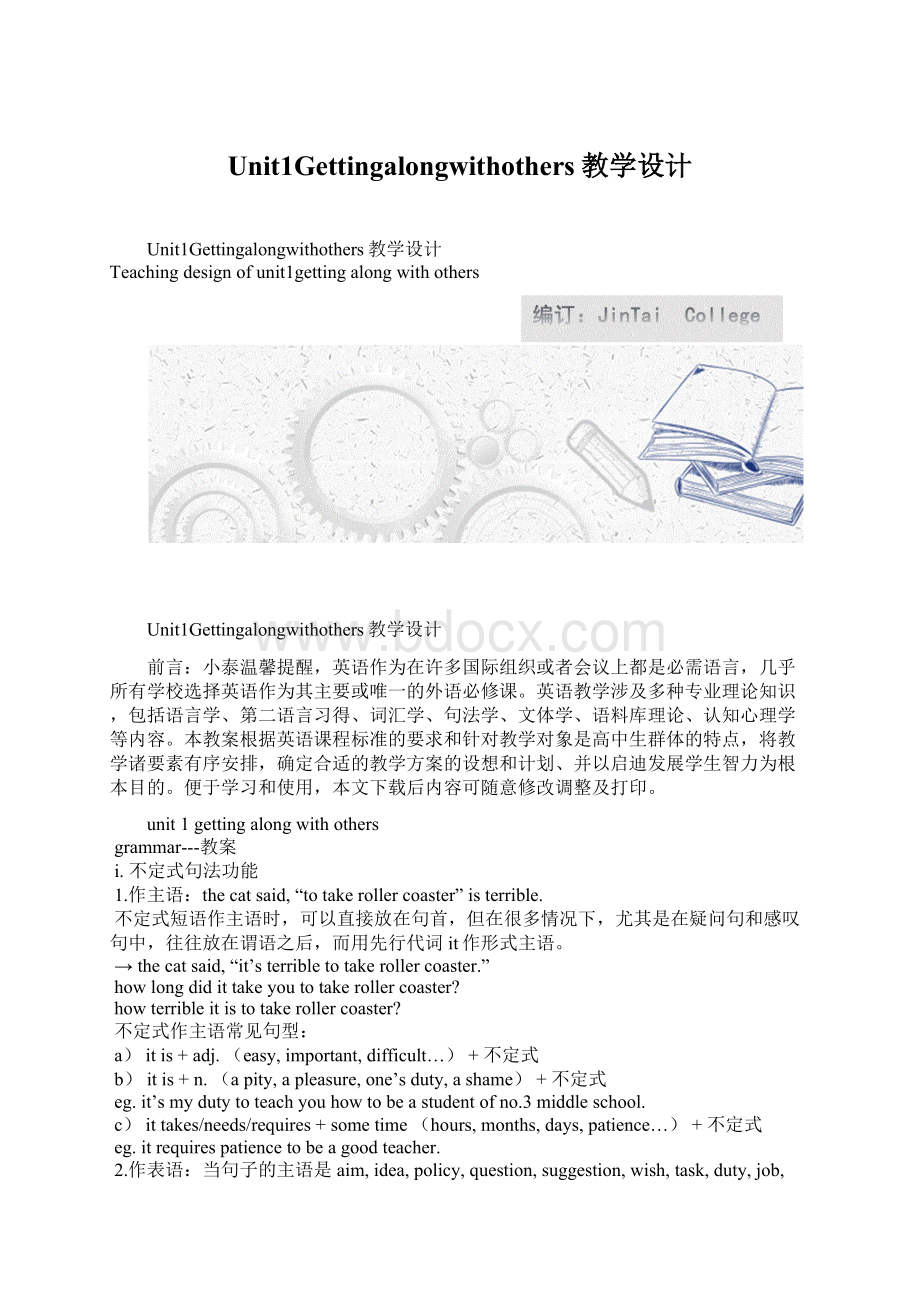Unit1Gettingalongwithothers教学设计.docx
《Unit1Gettingalongwithothers教学设计.docx》由会员分享,可在线阅读,更多相关《Unit1Gettingalongwithothers教学设计.docx(6页珍藏版)》请在冰豆网上搜索。

Unit1Gettingalongwithothers教学设计
Unit1Gettingalongwithothers教学设计
Teachingdesignofunit1gettingalongwithothers
Unit1Gettingalongwithothers教学设计
前言:
小泰温馨提醒,英语作为在许多国际组织或者会议上都是必需语言,几乎所有学校选择英语作为其主要或唯一的外语必修课。
英语教学涉及多种专业理论知识,包括语言学、第二语言习得、词汇学、句法学、文体学、语料库理论、认知心理学等内容。
本教案根据英语课程标准的要求和针对教学对象是高中生群体的特点,将教学诸要素有序安排,确定合适的教学方案的设想和计划、并以启迪发展学生智力为根本目的。
便于学习和使用,本文下载后内容可随意修改调整及打印。
unit1gettingalongwithothers
grammar---教案
ⅰ.不定式句法功能
1.作主语:
thecatsaid,“totakerollercoaster”isterrible.
不定式短语作主语时,可以直接放在句首,但在很多情况下,尤其是在疑问句和感叹句中,往往放在谓语之后,而用先行代词it作形式主语。
→thecatsaid,“it’sterribletotakerollercoaster.”
howlongdidittakeyoutotakerollercoaster?
howterribleitistotakerollercoaster?
不定式作主语常见句型:
a)itis+adj.(easy,important,difficult…)+不定式
b)itis+n.(apity,apleasure,one’sduty,ashame)+不定式
eg.it’smydutytoteachyouhowtobeastudentofno.3middleschool.
c)ittakes/needs/requires+sometime(hours,months,days,patience…)+不定式
eg.itrequirespatiencetobeagoodteacher.
2.作表语:
当句子的主语是aim,idea,policy,question,suggestion,wish,task,duty,job,purpose等或者主语是what引导的名词性从句时,后面可以用不定式做表语,用以说明主语所包含内容。
eg.ourmostimportanttasknowistomakeaplan.
注:
作表语的不定式都带to,但当主语部分有实义动词do时,to可以省略。
eg.theonlythingwecandonowiswaitandsee.
3.作宾语
thecatsaid“remembernottotakeitnexttime!
”.
a)可以直接用不定式作宾语的动词很多,常见的有:
agree,afford,tend,ask,decide,determine,expect,fail,hope,learn,intend,manage,offer,plan,promise,refuse,want,wish等
XX年天津卷12题:
idon’twant_____likei’mspeakingillofanybody,butthemanager’splanisunfair.
a.tosound b.tobesounded c.sounding d.tohavesounded
当不定式短语比宾补长时,往往将不定式放到宾补后,而用先行代词it作形式宾语,常用动词有feel,think,find,believe,consider,make等。
thecatfeltitterribletotakerollercoaster.
b)不定式一般不作介词的宾语,只有少数介词如but,except等后面可以跟不定式作宾语。
一般情况下作介词宾语的不定式都带to,如果but或except所在句子里的谓语动词都是实义动词do,does,did时,通常省略to。
eg.wehavenochoicebuttowait.
cf.wecandonothingbutwait.
4.宾语补足语
在svoc句型中,许多动词都可以按不定式作宾语补足语。
a)通常作宾语补语的不定式要带to,常用于以下动词之后:
ask,tell,advise,allow,enable,expect,force,get,like,order,teach,want,invite,wish,beg等
youshouldgetthemtohelpyou.
但在谓语动词believe,find,think,feel,consider,suppose,imagine,prove等后面跟tobe…作宾补,不跟todo…
eg.theybelievehimtobehonest.
b)以下两类动词后跟不定式作宾补时不能带to
①一些表示“致使”意义的动词,如:
let,have,make等
②一些表示感觉的动词,如:
hear,feel,see,watch,notice等
don’tletthechildrentroubleyou.
iheardsomeoneopenthedoor.
但当这两类动词为被动态时,不定式就成了主补。
作主补的不定式必须加上to
hisfathermadehimgotobedearly.
→hewasmadetogotobedearlybyhisfather.
5.作定语
不定式可以在句子充当后置定语,修饰名词。
以下几类情况常用不定式作定语:
①能带不定式作宾语的动词,其同源名词可以带不定式作定语。
常见的有attempt,decision,promise,plan等
eg.hehasn’tkepthispromisetowritetohisparentsregularly.
②常与不定式搭配的形容词,其同源名词一般可以用不定式作定语。
常见的有ability,determination,anxiety,eagerness等
eg.hiseagernesstofinishhishomeworkwasquiteclear.
③序数词形容词最高级或被only,last,next等修饰的名词可以用不定式作定语:
shewastheonlypersontosurviveaftertheearthquake.
tips:
不定式在作定语时,有时与被修饰的名词有意义上的主谓关系、同位关系、动宾关系,如果该不定式是不及物动词,它后面需要加上适当介词。
eg.he’salwaysthefirsttocomeandthelasttoleave.主谓关系
i’venotimetolistentoyourexcuse.同位关系
shehasameetingtoattend.(动宾关系=attendameeting)
there’snothingtoworryabout.(动宾关系=worryaboutnothing)
6.作状语
不定式可以作状语,表示目的、结果、原因、条件等。
①to…,inorderto…,soasto…(不能放在句首)作目的状语
XX年辽宁卷22题:
allthesegiftsmustbemailedimmediately_____intimeforchristmas.
a.inordertohavereceived b.inordertoreceive c.soastobereceived d.soastobereceiving
②在so…asto,such….asto,onlyto…结构中不定式作结果状语,其中onlyto…用于表示意想不到的结果。
hehurriedtothestationonlytofindthetrainhadgone.
③enoughto,too…to结构
eg.theboyisn’toldenoughtogotoschool.
=theboyistooyoungtogotoschool.
④形容词(happy,glad,lucky,fortunate,surprised,angry,anxious,ready,quick,slow,cruel,clever等)+不定式结构
eg.i’mgladtomeetyou.
thequestionisdifferenttoanswer.
heishardtogetalongwith.
7.作插入语,用来说明说话人的态度、看法、对整个句子进行解释,如tobefrank(坦白地说),tobesure(确实)等。
eg.totellyouthetruth,ihateyou.
8.作同位语
eg.theordertostartthegeneralattacksooncame.
不定式的复合结构,以it为形式主语或形式宾语引导的复合结构,如果其前的形容词是指行为的性质就用:
forsb.todosth.这种复合结构在句中可作主语、表语、宾语、定语、状语等。
itisnecessaryformetolearnenglishwell.
如果该形容词是指行为的性质,同时又指行为的人,则用ofsb.todosth.。
这种句式中的常用形容词有:
right,wrong,brave,careful,careless,clever,wise,stupid,cruel,foolish,good,honest,kind,nice,silly等。
eg.it’sverykindofyoutocometoseeme.
连接代(副)词+不定式(包括whether,what,which,whom,where,when,how,不包括why),在句中起名词的作用,通常跟在诸如tell,know,show,decide,learn,wonder,explain等动词后作宾、主语或表语。
eg.noonecantellmewheretofindjohn.
whentotheexamisstillunknown.
theproblemishowtogetenoughmoney.
不定式的进行式、完成式和被动式
①不定式的进行式由tobe+v-ing构成,用来表示谓语动词动作发生时,不定式的动作正在进行。
eg.somestudentspretendedtobereadingenglishwhentheteachercamein.
②不定式完成式由tohave+v-ed构成,用来表示动作发生在谓语动作之前。
eg.XX年江苏卷no.25
---isbobstillperforming?
---i’mafraidnot.heissaid_______thestagealreadyashehasbecomeanofficial.
a.tohaveleft b.toleave c.tohavebeen d.tobeleft
答案是a
③不定式的被动式分为一般式被动tobev-ing和完成式被动tohavebeenv-ed。
当不定式的逻辑主语是不定式所表示的动作的承受者时,不定式要用被动语态。
eg.itisanhonourformetobeinvitedtotheparty.
thebookissaidtohavebeentranslatedintomanylanguages.
XX年辽宁卷no.22
allthesegiftsmustbemailedimmediately_____intimeforchristmas.
a.inordertohavereceived b.inordertoreceive c.soastobereceived d.soastobereceiving
动名词
1.动名词的句法功能:
动名词由动词加ing构成,与现在分词的形式相同。
动名词主要起名词作用,在句中担任主语、表语、宾语和定语。
①作主语,可以直接放在句首,也可以用先行代词it作为形式主语,而把动名词后置。
eg.seeingisbelieving.(眼见为实)
sayingiseasierthandoing.
collectingstampsisagoodhobby.(单个动名词短语作主语时,动词用单数)
动名词作主语还有以下两个习惯表答法:
itisnouse(good)+动名词:
做某事没有用
eg.it’snousecryingoverspiltmilk.(覆水难收)
thereisno+动名词(=itisimpossibletodosth.)
eg.thereisnoknowingwhatmayhappen.(未来的事无法知道)
②作表语:
通常是说明主语的内容,注意它与谓语动词进行时的区别
eg.hishobbyiscollectingstamps.(此句为svc结构)可改为:
collectingstampsishishobby.
cf.heiscollectingstamps.(iscollecting是谓语动词进行时,此句为svo结构)
不能改为:
collectingstampsishe.
③作宾语
a.作及物动词的宾语(enjoy,mind,finish,appreciate,avoid,consider,delay,escape,pratise,suggest,keep(on),miss)
eg.XX年上海卷no.32
hegotwell-preparedforthejobinterview,forhecouldn’trisk_____thegoodopportunity.
a.tolose b.losing c.tobelost d.beinglost
答案为b
有些动词(attempt,begin,continue,hate,like,love)后面既可以接不定式作宾语,也可以接动名词作宾语,意义差别不大。
通常认为用动名词泛指一般的倾向性,用不定式则表示特定或具体某一种动作。
eg.ilikeswimmingbutidon’tliketoswiminwinter.
动词prefer后面接不定式作宾语时,句子结构与按动名词作宾语是不一样。
eg.iprefertodriveratherthantobedriven.
ipreferdrivingtoriding.
有些动词,如forget,remember,regret等,后面接动名词表示的动作先于谓语动词动作,不定式表示的动作后于谓语动词。
eg.XX年北京卷no.30
whenaskedbypolice,hesaidthatheremembered_____atheparty,butnot______.
a.toarrive,leaving b.toarrive,toleave c.arriving,leaving d.arriving,toleave
在下列句型中动名词作真正宾语:
动词+it(形式宾语)+宾补+动名词(真正宾语)
eg.ithinkitnousetellingthem.
wethinkitnogoodinvitingtohim.
b.作介词的宾语
eg.XX年浙江卷no.3
thepresidentspokeatthebusinessmeetingfornearlyanhour______hisnotes.
a.bringingup b.referringto c.lookingfor d.tryingon
beusedtodoing习惯于做;lookforwardtodoing盼望做;devoteone’slifetodoing致力于做;spenttime(in)doing花时间做;befondofdoing喜爱做;begoodatdoing擅长做;beproudofdoing为做…而自豪;betiredofdoing对做…感到厌倦;feellikedoing欲想做;goondoing继续做(原来的事);keepondoing不停地做;whataboutdoing做…怎么样;thinkofdoing考虑做;beinterestedindoing对做…感兴趣;havesomedifficulty/trouble(in)doing做某事有困难;bebusy(in)doing忙于做;insteadofdoing做…而不做…
eg.XX年江苏卷no.23
everybodyinthevillagelikesjackbecauseheisgoodattellingand______jokes.
a.turningup b.puttingup c.makingup d.showingup
答案为c
④作定语
动名词可作前置定语,表示所修饰的词的用途或目的,可用for改写;而现在分词作定语时,可用定语从句改写。
swimmingpool waitingroom walkingstick
asleepingcar=acarforsleeping asleepingchild=achildwhoissleeping
⑤作同位语
eg.that’sthequeen’sfull-timejob,layingeggs.这就是蚁后的专职工作——产卵。
2.动名词的逻辑主语
①人称代词做逻辑主语时应用所有格,即形容词性物主代词。
eg.doyoumindingmysmokinghere?
②逻辑主语是不定代词或指示代词时,很少用所有格,而用普通格。
eg.hewasawakenedbysomeoneknockingthedoor.
there’snoneedforthatbeingdone.
③逻辑主语是名词时,用所有格,但是如果名词为无生命物体时,则用普通格。
eg.mary’slaughingmadetomangry.
thereisnohopingofthefactorymakingprofit.
④在口语中,动名词如果不在句首,可以用名词普通格或人称代词宾格作逻辑主语。
eg.XX年安徽卷no.34
ireallycan’tunderstand_____herlikethat.
a.youtreat b.youtotreat c.whytreat d.youtreating
3.动名词的完成式、一般式被动和完成式被动。
eg.afterhavingfinishhiswork,hewenthome.
heattendedthemeetingwithoutbeingasked.
shenevertoldmeaboutherhavingbeeninterviewedbythepolice.
--------DesignedByJinTaiCollege---------